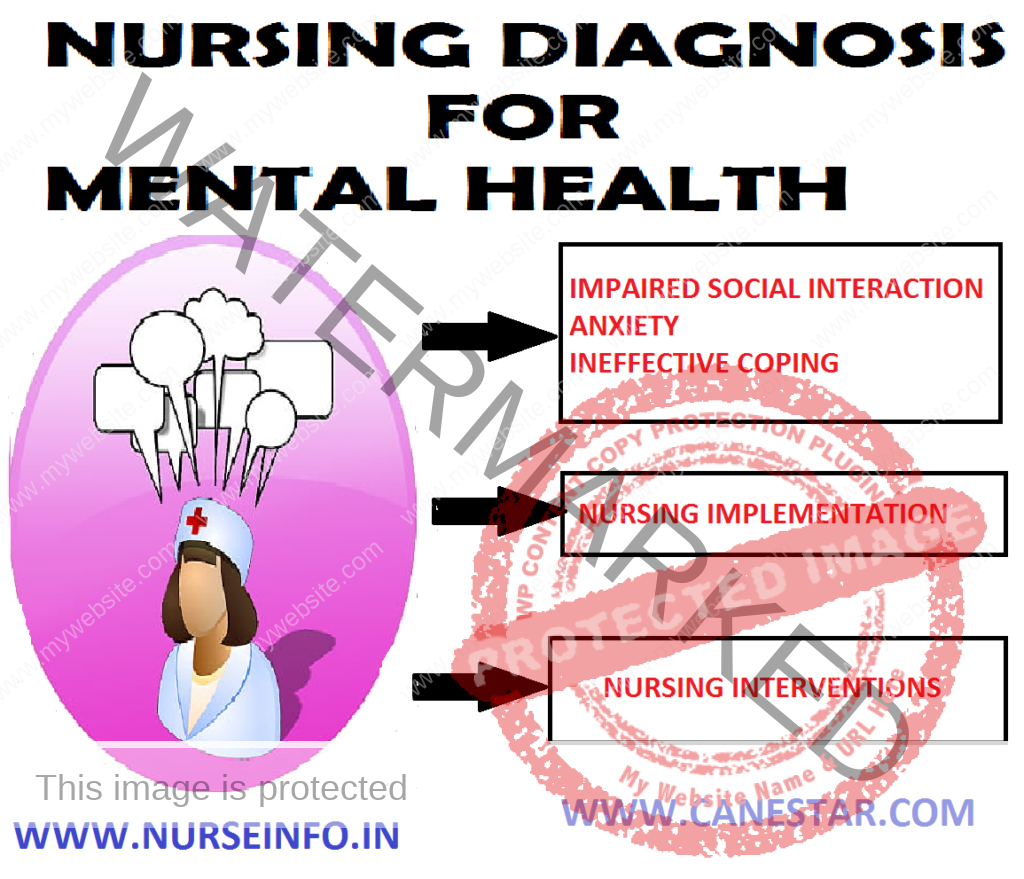NURSING DIAGNOSIS
Nursing diagnosis is defined as clinical judgments about individual, family or community responses to actual and potential health problems. Nursing diagnoses are used to describe nursing interventions, and to delineate the parameters for developing outcome criteria.
A nursing diagnosis statement consists of the problem of patient response and one or more related factors that influence or contributes to the patient’s problem or response; signs and symptoms or deficiency characteristics or subjective and objective assessment data that support the nursing diagnosis.
The basic level psychiatric nurse identifies nursing problems by using the nomenclature specified by the North American Nursing Diagnoses Association (NANDA).
A nursing diagnosis describes an existing or high-risk problem and requires a three-part statement.
- The health problem (Problem, ‘P’)
- The etiological or contributing factors (Etiology, ‘E’)
- The defining characteristics (Signs and symptoms, ‘S’)
For example:
- High-risk for self-directed violence related to depressed mood, feeling of worthlessness, anger turned inward on the self
- Powerlessness related to dysfunctional grieving process, lifestyle of helplessness, evidenced by feelings of lack of control over life situations, over dependence on others to fulfill needs.
Planning
Planning involves setting and prioritizing goals, formulating nursing interventions and developing a care plan in conjunction with the patient based on the nursing diagnoses chosen.
- Specific patient needs
- Consideration of the patient’s strengths and weaknesses
- Encouragement of the patient to help set achievable goals and participate in his own care
- Feasible interventions
Nursing interventions with rationale are selected in the planning phase based on the patient’s identified risk-factors and defining characteristics. The process of planning includes:
- Collaboration by the nurse with patients, significant others, and treatment team members
- Identification of priorities of care
- Critical decisions regarding the use of psycho therapeutic principles and practices (identify the most appropriate nursing intervention)
- Coordination and delegation of responsibilities
In this, the nurse will choose nursing interventions appropriate to an individual’s identified problem with specific expected outcomes.
Once the nursing diagnoses are identified, the next step is the prioritization of the problems in order of importance. Highest priority is given to those problems that is life threatening. Next in the priority are those issues that are related to normative or developmental experiences. Psychiatric nurses often use Maslow’s hierarchy of needs to prioritize nursing diagnosis.
Outcome Identification
Outcomes can be defined as a patient’s response to the care received. Outcomes are the end result of the process. Measuring outcomes not only demonstrates clinical effectiveness, but also helps to promote rational clinical decision making on the part of the nurse. Each outcome must follow certain criteria.
- Relate directly to the nursing diagnosis
- Be measurable, time limited, and realistic
- Be stated as a desired patient outcome of nursing care
- Reflect the desires of the patient and his family
- Be stated in a way that the patient and his family can understand
Diagnosis: Impaired social interaction (isolates self from others)
Outcome: Patient will attend group sessions everyday
Intervention: Using a contract format explain the role and responsibility of patients
Correct and Incorrect Outcome Statements
Nursing Diagnosis – Anxiety
Correct Outcome- Verbalizes feeling, calm, relaxed, with absence of muscle tension and diaphoresis; practices deep breathing
Incorrect Outcome- Exhibits decreased anxiety, engages in stress reduction
Nursing Diagnosis- Ineffective Coping
Correct Outcome- Makes own decisions to attend groups; seeks staff for interaction
Incorrect Outcome- Demonstrates effective coping abilities
Implementation
In the implementation phase nurse sets interventions prescribed in the planning phase.
Nursing interventions (also known as nursing orders or nursing prescriptions) are the most powerful pieces of the nursing process. Interventions are selected to achieve patient outcome and to prevent or reduce problems. Implementation serves as a blueprint of plan.
Nursing interventions are classified as independent, interdependent and dependent.
Nursing Intervention in Psychiatric Nursing
Interventions for biological dimension:
- Self-care activities
- Activity and exercise
- Nutritional interventions
- Hydration interventions
- Thermoregulation intervention
- Pain management
- Medication management
Interventions for Psychological Dimension:
- Counseling interventions
- Conflict resolutions
- Bibliotherapy
- Reminiscence therapy
- Relaxation interventions
- Behavior therapy
- Cognitive therapy
- Psychoeducation
- Spiritual interventions
Interventions for social dimensions:
- Group interventions
- Family intervention
- Milieu therapy
Evaluation
Evaluation is the process of determining the value of an intervention. Nurses determine the effectiveness of interventions with particular patients. Nurses evaluate selected interventions by judging the patient’s progress towards the outcome set down in the nursing care plan.


